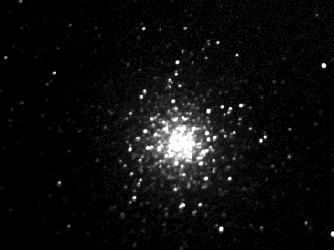The "Globs" of Summer
Jack Kramer
It seems as though each season of the year is known for a certain type of deep sky object. While there are exceptions, we do tend to associate winter with open clusters and spring with galaxies. If that's the case, then summer surely has to be the season of globular clusters. It's easy for the average observer to tick off some of the more renowned gems, such as M13, M4 and M22. Understanding something about their nature will make the observation of these objects more interesting.

This picture is one of Mike Purcell's CCD images of M13, and while the reproduction process hardly does it justice, it does illustrate a common feature of globulars - their increasing degree of concentration toward the center. But they're not all alike; prolonged observation will reveal both major and subtle differences from one to another. In a way, globulars are one of the more mysterious deep sky objects, because little is known about how or why they came to be formed. In general, they are composed of older stars, though they are not all of the same age. They also tend to be concentrated toward the center of our galaxy...that's why there are more of them visible in the summer sky. There are two types - halo globulars and disk globulars. The more numerous halo type are located at the very edge of the Milky Way scattered "above" and "below" the hub of our galaxy. The disk type are located within the plane of the galaxy, but they, too, are congregated toward the center of the galaxy. Deep photographs of other nearby galaxies show many with their own halos of globular clusters.
Now for the fun part. Globulars take high magnification very well, and may require it in order to resolve the components. What else should you look for in your telescope?
Color - Visual observation with observatory-size telescopes readily shows a variety of different colors in the stars that make up globulars. One observer described the effect as though he were looking into a "jewel box". Those of you with larger telescopes also may be able to detect some colors. Since the eye is not sensitive to color at low light levels, it takes quite a bit of light grasp.
Stellar Distribution - Probably you've read about "star poor" areas in globulars; this is more than just a varying distribution at the edges. M13 is a good example where the density of the stellar components varies, with star poor areas spiraling in toward the center. Sometimes this effect is more pronounced than at other times. M22 also appears to me as though there are sprays of stars emanating from the core, which doesn't seem to be exactly at the center. M30 in Capricornus has two short lines of stars emanating from the hub. M4 in Scorpius is famous for its vertical line of bright stars running through the center.
Density - This refers to the richness of the cluster. Some are so dense that individual components cannot be detected at the center, while others are so loose that they hardly look like globulars. M71 in Sagitta is so loose that it appears fainter than you'd expect and it lacks the typical dense central condensation. In fact, there have been questions whether it's a true globular. M5 in Serpens is very rich and has a bright central hub, but is fairly loose throughout. For this reason, it's one of the most beautiful clusters in our sky. From New Mexico, NGC 288 in Sculptor actually gave the impression of being richer at the edges than at the center. And Omega Centauri is so large and dense that it's almost beyond words...but it's only visible from more southern latitudes.
Shape - As the name implies, globulars are...well...round. But not always! NGC 6934 in Delphinus appeared to have roughly the shape of a gibbous moon in my 10" - this may have been due to a large star-poor area on one side of the cluster. M56 in Lyra and M92 in Hercules also give the impression of irregular shape. In fact, it's quite common for globulars to appear oval, perhaps due to stellar distribution at the edges.
The globulars referred-to here have all been bright and easy objects; of course, many of those in atlases such as the Tirion 2000 are so small that they appear as nothing more than fuzzy stars. But don't be reluctant to hit them with your highest magnification, if conditions permit...you just may be able to break them apart ! What about seeing the globulars in other galaxies? Believe it or not, this is possible with the very largest amateur telescopes. They would appear as very faint stars near the hub of a galaxy such as M31, but they would be fainter than 14th magnitude.
Published in the December 1993 issue of the NightTimes




